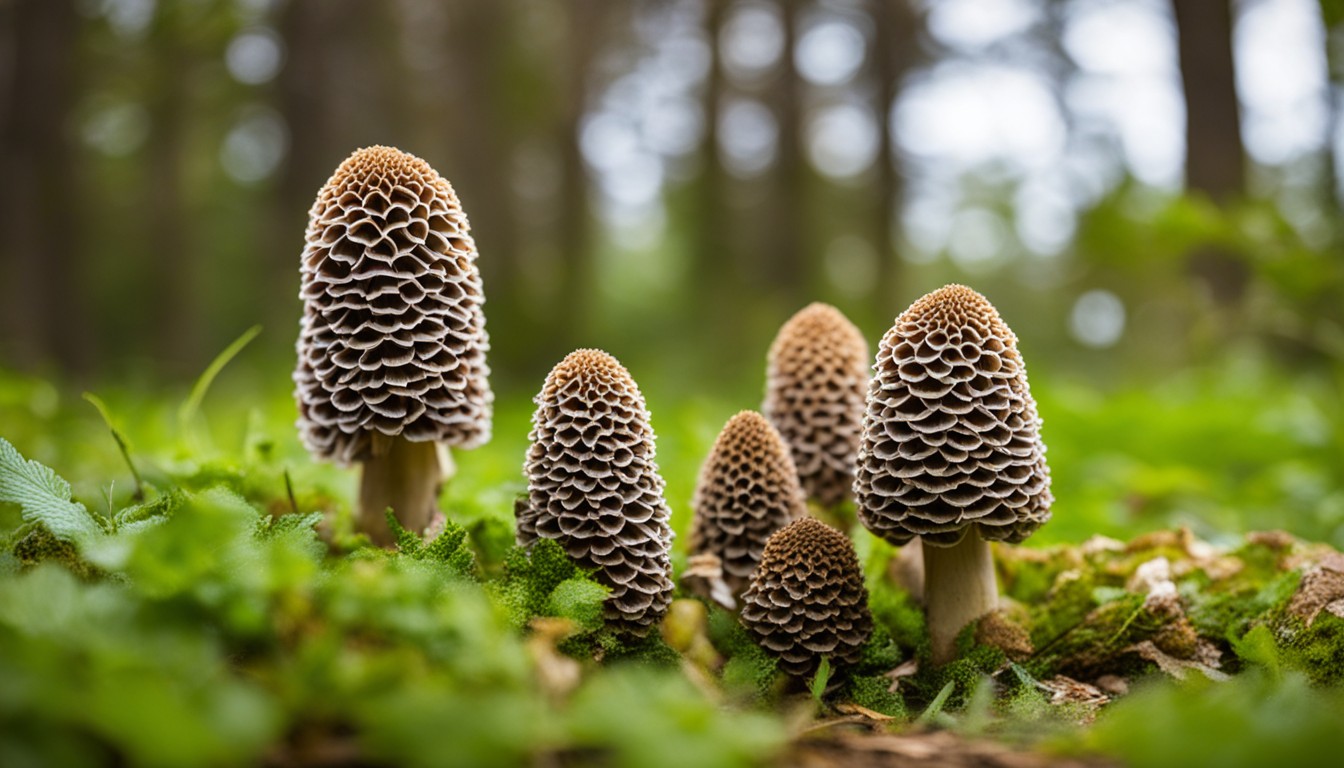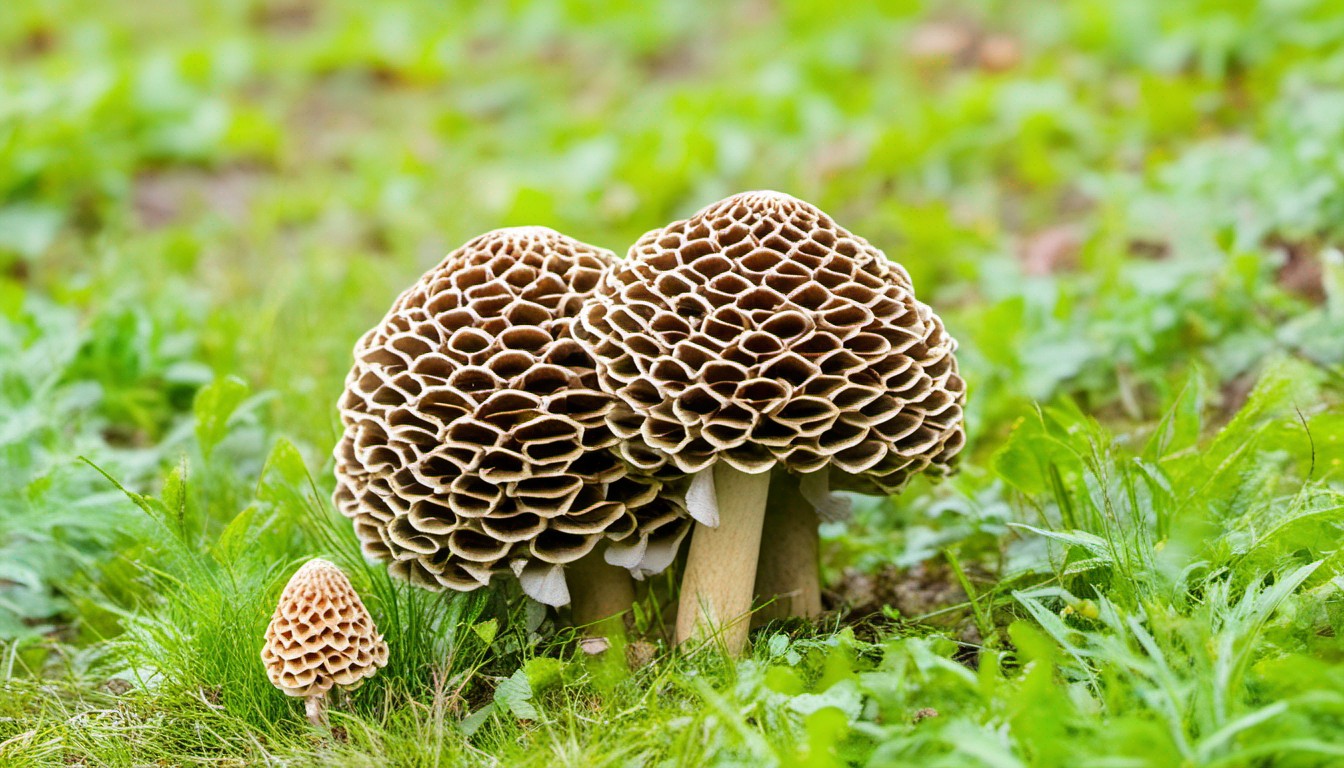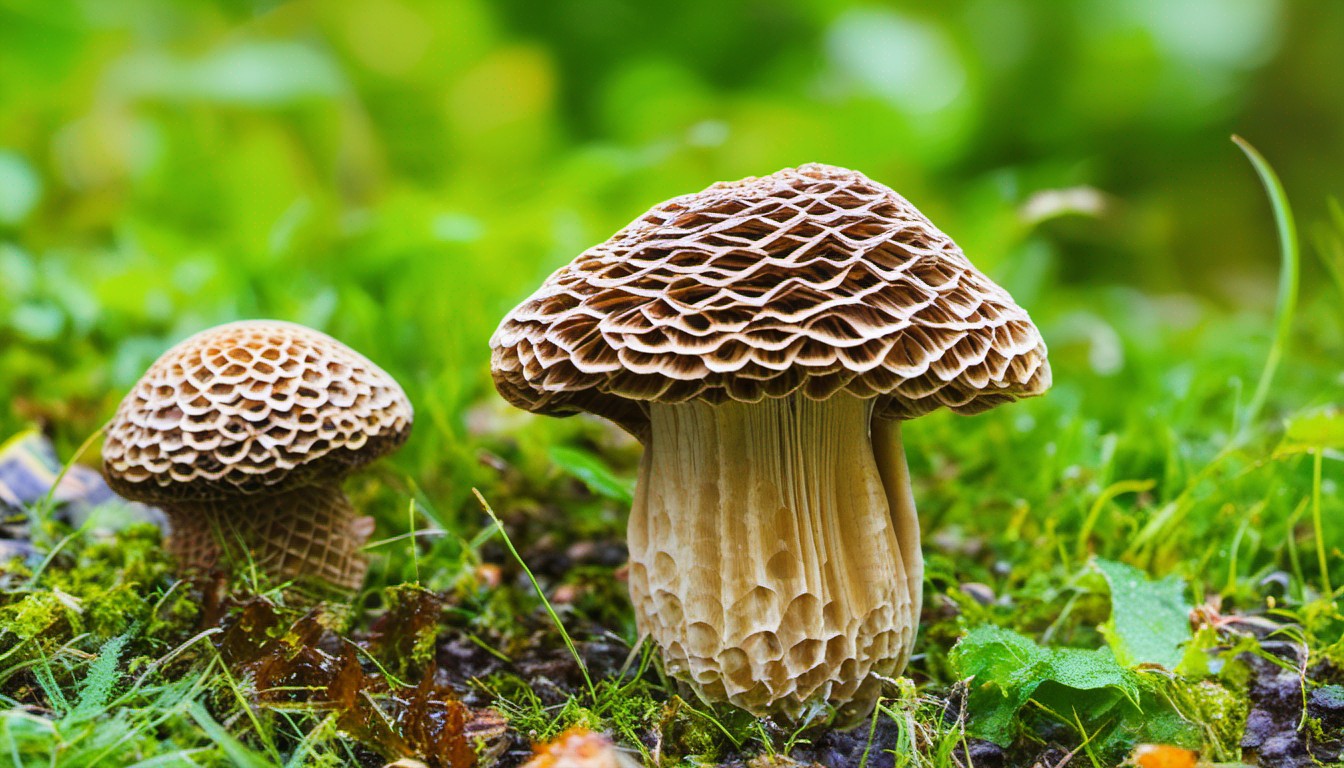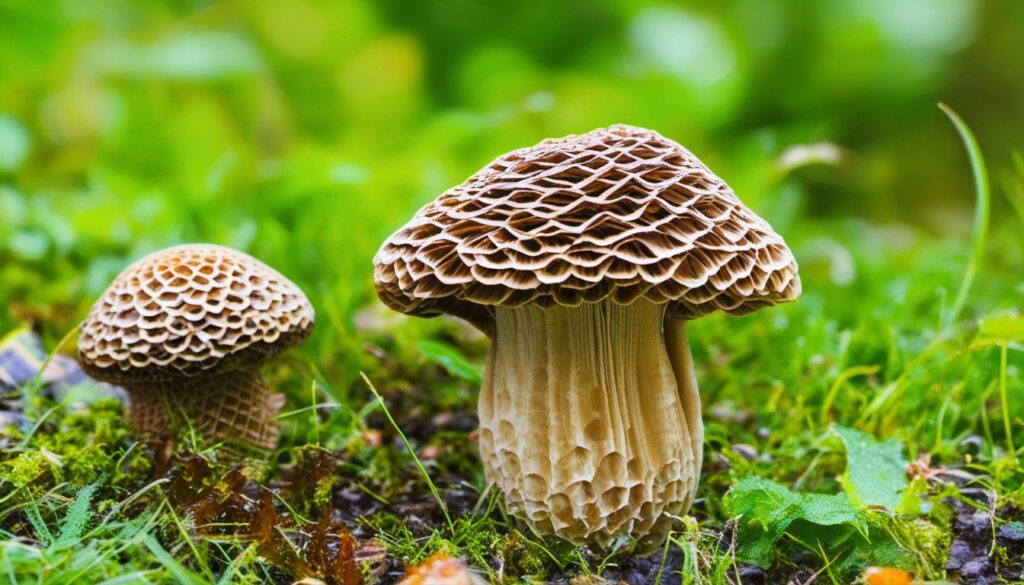Morel mushrooms are a sought-after delicacy in Utah, and finding and harvesting them can be a rewarding outdoor activity. In this expert guide, we provide valuable advice on where and how to find these elusive mushrooms in the wild. From understanding the ideal growing conditions to exploring the best locations across the state, we leave no stone unturned in our quest to help you become a morel mushroom foraging expert. So grab your basket and hiking boots, and get ready to embark on a thrilling culinary adventure in the beautiful wilderness of Utah.
What are Morel Mushrooms?
Morel mushrooms, known scientifically as Morchella, are an intriguing category of fungi that exhibit a distinctive, honeycombed appearance. Prized for their earthy, nutty flavors, these mushrooms are often considered a delicacy and are avidly sought after by culinary enthusiasts and foragers alike.
Introduction to Morel Mushrooms
Morel mushrooms, famed for their honeycomb-esque appearance and rich flavor, are an esteemed variety among fungi enthusiasts. They are primarily lauded for their unique taste and the exciting hunt they instigate each spring.
Starting from the discovery on the forest floor to the satisfaction of cooking in our kitchens, Morel mushrooms provide a delightful gastronomic experience. This culinary journey encapsulating foraging, identifying, storing, and cooking, highlights the essence of Morel mushrooms.
Why are Morel Mushrooms Popular in Utah?
Morel mushrooms have claimed considerable popularity within Utah’s diverse ecosystem. This adulation stems from their nuanced flavors, bountiful harvest, and the thrill of hunting these capricious fungi in the state’s truly spellbinding terrains.
The varied ecosystems in Utah have created a rich culture for Morel mushroom hunting, transforming it into both a culinary pastime and thrilling treasure hunt amidst diverse terrains.
Utah’s unique terrain blends mountainous regions and moist woodlands, offering perfect breeding grounds for Morel mushrooms. This blend of habitats not only nurtures diverse Morel species, but also makes the state a hunter’s delight, adding an exciting treasure hunt aspect to the mix.
Ideal Environmental Conditions
Utah’s geographical conditions play a decisive role in making it a preferred habitat for Morel mushroom growth. The state’s varied terrain, ranging from fertile valleys to montane forests, provides ample ground for these fungi to thrive.
Another key element in this equation is Utah’s unique climate. Its dynamic weather patterns, marked by cold winters and moist springs, set the stage for optimal morel mushroom development. This period of renewal right after the thaw sets the mood for morels to sprout in abundance.
In this environment, morel mushrooms find a delightful dance of conditions. Moist soil, complemented by ample sunshine and sporadic rainfalls, offers the raw materials these mushrooms need to proliferate, coupled with the abundance of organic matter in Utah’s forests.
The interaction of these factors creates an environment that is incredibly favorable to morels. As spring warms up the earth, morel spores naturally do what they do best, grow and reproduce, hereby making Utah a prime locale for these prized edibles.
From the rich deciduous forests to the river valleys, Utah’s diverse ecology paints a vibrant backdrop for these mushrooms. Each area’s distinct environment intricacy further reinforces the state’s reputation as a haven for morel mushroom hunters.
Unique Morel Varieties Found in Utah
Utah’s diverse topography plays host to a vibrant palette of Morels, each strain accentuating the richness of the state’s mushroom treasure trove. From the nuanced flavors of blond morels to the creamy undertones of the black morel, the Utah landscape is a haven for fungal connoisseurs.
The morel varieties exclusive to Utah form an irresistible allure for mushroom enthusiasts. Of these, the standout is the ‘Morchella sextelata,’ a uniquely patterned morel that marries culinary delight with the thrill of the hunt.
These distinct Morchella species not only add to the state’s ecological richness but also offer gourmet ingredients to chefs and home cooks alike. Utah’s Morel diversification is indeed a testament to the state’s unparalleled fungal framework.
When and Where to Find Morel Mushrooms in Utah

Timing is a crucial aspect in the hunt for Morel mushrooms in Utah, with the season typically commencing in late April and extending to mid-June. Monitoring local temperatures and rainfall can offer valuable foresight, as Morels flourish following warm spring rains.
Unearthing the best spots for Morel mushroom foraging involves acknowledgment of the mushroom’s preferences. In Utah, these fungi mainly inhabit high-altitude areas near dead or dying trees, particularly in mountain aspen and spruce groves. Topographical maps and local foraging communities can provide useful insights.
Seasonal Availability
The best time to hunt for morel mushrooms in Utah typically synchronizes with spring. The onset of warm weather and melting snow create the optimal conditions for morels to sprout. This period usually falls between late April and June.
The seasonal changes in Utah greatly affect the Morel mushroom availability. When winter turns into spring, and the temperature starts to balance between 60 to 70 degrees Fahrenheit during the day, Morels begin to surface.
Notably, morel mushrooms require a combination of warmth and moisture to thrive. A massive snowfall in the winter that melts gradually into the spring is an ideal scenario. This moist environment coupled with warmer days facilitates Morel growth.
Nonetheless, window for hunting morels is fleeting. As spring progresses into summer, and daytime temperatures rise above 80 degrees Fahrenheit, morel mushrooms begin to die off.
Moreover, early spring after forest fires the previous year can yield a bumper crop of morels. The mushrooms thrive in the nutrient-rich, burned areas, making burnt forests in Utah a key habitat during their growing season.
Preferred Terrains
Drawing from a diverse landscape, Utah houses a range of environments conducive to morel mushroom growth. From the verdant valleys of the Wasatch Range to the creek beds in high mountain areas, these terrains offer optimal conditions for morels.
Evidence suggests that morel mushrooms favor recently disturbed ground. Thus, areas recovering from wildfires, prescribed burns, or logging activities become hotspots for these elusive fungi.
Just as varied are the terrains in which Utah’s morels choose to establish, so is the need for a keen eye and understanding of these landscapes. Observing natural signs like dying elms or cottonwood trees can lead to prospective morel terrains.
Tracing back to past forest fires can yield valuable clues to morel landscapes. Since these fungi subsist on decaying organic matter, they often emerge one to three years after a fire, making fire maps valuable companions in the hunt for Utah morels.
Hotspots for Morel Mushroom Hunting
In the quest for Morel mushrooms in Utah, certain locations have proven favourable due to happy accident, or often due to a nature-induced bounty. This is why certain hotspots have become well-known among local foragers.
- From the Uinta Mountains to Fishlake National Forest: these places not only offer a stunning view but are also known for their generous crop of Morel mushrooms.
- Moab’s creek banks, particularly post-wildfire zones, have been regarded as a haven for these coveted fungi.
- Morel hunters have found success in the Cedar Breaks National Monument region.
- The Provo River area and its mountain landscapes provide ideal conditions for Morel growth and proliferation.
Tips for Successful Morel Mushroom Harvesting in Utah

Morel mushrooms are treasures of the forest, but their rarity can make them elusive. Fortunately, Utah’s morel hunters have cultivated a wealth of knowledge over the years. They suggest inspecting the ground carefully at different angles, as the shape and color of morels often blend with the natural forest floor. Key identifiers such as honeycomb cap structure and a hollow core can help you confirm a genuine find.
Experience has shown that morel mushrooms have particular preferences for growing conditions. While hunting, target recently burned forests or areas near dying or dead trees. Harvesting enhances future growth, but don’t pull mushrooms out from the roots; instead, cut at the base. Respect the land, leaving room for new morels to flourish.
Expert Advice on Identifying Morels
True Morel mushrooms, known scientifically as Morchella, can be identified by their honeycomb-like exterior and hollow, elongated body. The cap and stem are typically one continuous piece, a distinguishing feature unique to this fungal species.
Keep an eye out for false Morels: the dangerous imitators of authentic Morels. They often have a filled, cottony interior and the cap doesn’t connect seamlessly to the stem, unlike true Morels. Be diligent and cautious to ensure a safe mushroom hunt.
Tools and Supplies You’ll Need
Being properly equipped is an essential aspect of a successful morel hunting expedition. Here we delve into the key tools and supplies you’d need to create your personalized Morel Hunter’s Toolkit.
- Sturdy collection bag: A breathable fabric bag – typically mesh – will not only allow spores to escape and propagate but will also keep your morels in ideal condition.
- Morel hunting stick: This assists in rummaging through leaf litter or gently moving bushes aside— increasing your chance of spotting hidden morels.
- Field guide: A reliable field guide to mushrooms will help you correctly identify morel mushrooms versus any potentially dangerous lookalikes.
- GPS/Compass: For helping you find your way in the wilderness while tracking specific locations where you’ve found morels for future reference.
- Pocket knife: To cleanly harvest your found morels, ensuring minimal harm to the mycelium and allowing the organism to fruit again.
- Wearable Magnifying glass: Handy for examining mushrooms up close to confirm their identification.
- Comfortable, waterproof footwear: You’ll likely be walking and standing for extended periods, often in potentially wet or tricky terrains.
Harvesting and Handling Techniques
The procuring and handling of Morel mushrooms demand a considerable degree of expertise. Careful collection and storage practices play a crucial role in maintaining their gastronomic quality.
- Always cut Morel mushrooms at the base with a sharp knife instead of uprooting them to preserve their natural habitat.
- Gently brush away any soil or debris using a soft brush; never wash them in water as they quickly become soggy.
- Carry a breathable bag such as a mesh or a wicker basket while foraging. This not only keeps the mushrooms fresh by facilitating air circulation but also helps in spore propagation as you walk through the woods.
- After collecting, store Morel mushrooms in a cool, well-ventilated place. They can be kept in the refrigerator for about a week in a paper bag to maintain their quality.
- To prolong their shelf life, Morels can be dried or frozen. For drying, use a food dehydrator. If freezing, sauté them first to maintain their texture when defrosted.
Legal Regulations and Ethics for Morel Mushroom Hunting in Utah
Navigating the rules of the hunt in Utah means respecting local laws and permits for morel foraging. Consult regulatory bodies such as the Utah Division of Wildlife Resources and Forest Service to familiarize yourself with rules and season limits.
Mushroom ethics in Utah goes beyond understanding laws. They enforce appropriate forage behavior, such as only picking mature morels, minimizing environmental disturbances, and following ‘Leave No Trace’ practices to protect this highly prized natural resource.
Understanding Local Laws and Permits
Morel hunting in Utah does require adherence to specific legal parameters. You’ll need to obtain a personal use permit for foraging, which remains active typically for the duration of the current season. Always keep the permit on your person while morel mushroom hunting.
While you have the right to hunt for morels in Utah, restrictions apply. Certain areas are restricted and off-limits for foraging, while other areas impose a limit on the quantity that individuals can gather. Check with local authorities, parks, or forestry officials for specific guidelines before you embark on your hunt.
Conservation and Leave No Trace Practices
The Ethical Forager highlights the importance of practicing conservation during Morel hunting. Ensuring the minimal impact on our environments requires not using rakes for harvesting to prevent damaging the mycelium, and only taking what you can consume.
Our duty as foragers goes beyond harvesting Morel mushrooms. The principle of ‘Leaving Legacy, Not Trace’ implies respect for nature by collecting sustainably, exploring with care and contributing to the propagation of more Morel mushrooms in Utah for future generations.
Recipes and Tips for Cooking Morel Mushrooms

Renowned chefs and culinary enthusiasts across Utah have crafted expert recipes that bring out the unique taste of morel mushrooms, seamlessly transitioning them from forest to plate. Emphasizing their earthy flavor profile, these dishes range from simple yet luscious morel-infused risottos to morel-stuffed pasta.
Understanding the science behind seasoning can significantly enhance your morel mushroom dishes. Acids, for instance, can help emphasize their earthy undertones, while a pinch of salt can balance the overall flavor. Butter or olive oil, used sparingly, can intensify the morel’s inherent flavors, creating a dish that captivates the taste buds while celebrating Utah’s local produce.
Delicious Morel Mushroom Recipes
Morel mushrooms readily lend their rich and earthy flavor to a variety of innovative recipes. Try them sautéed with garlic and white wine for a delectable side dish, or mix them into a hearty risotto for a unique twist.
When it comes to culinary creations, Morels harvested from Utah bring a distinctive touch. Their meaty texture pairs well with cheeses and herbs in stuffed mushrooms, or consider them in a creamy pasta sauce for an elevated dinner experience.
For adventurous foodies, turning these modest-looking mushrooms into something extraordinary is an exciting journey. From sizzling stir-fry dishes to unconventional, savory tarts, Morel mushrooms present endless gastronomic possibilities.
It’s essential to remember that Morel mushrooms are versatile, complementing numerous cuisines with their intense flavor profile. Experiment with your favorites, whether it’s integrating them into Asian-style broths or topping off a rustic, homemade pizza.
Cleaning and Storing Morels
To ensure your harvested morels maintain their flavor and texture, they must be carefully cleaned and stored. Employing best practices will allow you to enjoy your bounty beyond the seasonal period, thus truly prolonging your harvest.
- Brush off any loose dirt gently with a soft brush.
- Place mushrooms in a bowl of cold water and swirl around gently for a thorough clean.
- Lay out the mushrooms on a towel and pat dry gently to avoid bruising.
- For long term storage, morels can be dehydrated and stored in airtight jars.
- If you’d prefer to freeze them, blanch the morels before freezing to preserve flavor and texture.
- Always store in a cool, dark place such as a pantry or refrigerator.
Cooking Tips and Techniques
When it comes to cooking morel mushrooms, the goal is to unlock their unique, nutty flavor and achieve a just-right texture. Subtle nuances can make all the difference in taste and texture, so perfecting your cooking techniques is key.
- Tips to Boost flavors: Lightly saute Morels with butter to enhance their earthy notes.
- Adding a dash of white wine or brandy can likewise elevate their taste.
- Use fresh herbs such as thyme, rosemary, or sage for an aromatic twist.
- Tossing Morels in flour before sautéing gives them a nice crispy exterior.
- Try slow roasting or grilling Morels for a deeper, smoky flavor.
Unleashing the Secrets of Morel Mushroom Foraging in Utah
Discover the answers to some commonly asked questions about finding and harvesting morel mushrooms in Utah.
1. Where can I find morel mushrooms in Utah?
Morel mushrooms can be found in various locations across Utah, including forested areas, burn sites, and river valleys. Look for places with a mix of cottonwood, aspen, and coniferous trees, and where the soil is moist and well-drained.
2. When is the best time to hunt for morel mushrooms in Utah?
The morel mushroom season in Utah typically begins in late spring, usually around April or May, when the weather starts to warm up. However, the exact timing can vary depending on local weather conditions and elevation, so it’s best to keep an eye on local mushroom hunting forums or consult with experienced foragers.
3. What are the identifying features of morel mushrooms?
Morel mushrooms have a distinctive appearance with a honeycomb-like cap and a tall, hollow stem. The cap can vary in color, ranging from light tan to dark brown. It’s important to familiarize yourself with the unique characteristics of morel mushrooms and learn to differentiate them from similar-looking species to ensure a safe and successful foraging experience.
4. How should I harvest morel mushrooms?
When harvesting morel mushrooms, gently twist or cut the stem near the base to ensure the mycelium, the underground part of the mushroom, remains intact. Avoid using rakes or disturbing the surrounding vegetation to preserve the ecosystem. Remember to respect private property and obtain proper permits if foraging in designated areas.
5. What are some tips for storing and cooking morel mushrooms?
Freshly harvested morel mushrooms can be stored in a paper bag in the refrigerator for a few days. To cook them, clean the mushrooms thoroughly and sauté them in butter or olive oil for a delicious and earthy flavor. Morel mushrooms also pair well with other ingredients like garlic, shallots, and cream in various culinary preparations.
Now armed with these insights, you’re ready to embark on your morel mushroom hunting adventure in the scenic landscapes of Utah. Happy foraging!
Conclusion
Reflecting on the joys and challenges of Morel mushroom hunting in Utah, it becomes evident that it’s more than an outdoor activity. It’s an adventure that draws you closer to nature, testing both your patience and determination. The dazzling landscape, coupled with elusive Morel mushrooms, set a thrilling stage for every hunt.
Embracing Utah’s Morel mushroom abundance is not only a rewarding pastime but also a culinary adventure. The thrill of the chase is equally matched by the gratifying process of transforming your found treasures into mouth-watering dishes.
- Challenges often experienced include rough terrains, unpredictable weather, and the camouflaged nature of Morels.
- Joys consist of successfully locating elusive Morels, the consoling ambiance of nature, and the thrill of the hunt.
- In the culinary realm, the rich, nutty flavour of Morels adds depth to various dishes.
- The satisfaction of preparing a meal with Morels you’ve personally harvested, knowing each mushroom’s origin and effort invested.

